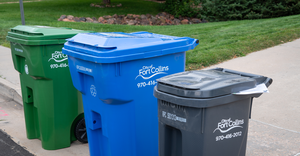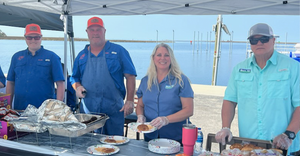Better for All Zeros in on PHA-made Party Cups While Planning for Future Products
When Better for All launched, the company’s plan was to develop and sell packaging to apparel brands made from polylactic acid (PLA), one of the early plant-based materials touted as an alternative to conventional plastics. Fast realizing that not all bioplastics are created equal, the team pivoted, going with a different biopolymer and carving out a whole new direction beyond choice in material.

When Better for All launched, the company’s plan was to develop and sell packaging to apparel brands made from polylactic acid (PLA), one of the early plant-based materials touted as an alternative to conventional plastics. Fast realizing that not all bioplastics are created equal, the team pivoted, going with a different biopolymer and carving out a whole new direction beyond choice in material.
Today the California startup fixes its attention on cups made from polyhydroxyalkanoate (PHA), a biopolymer created leveraging bacteria that break it down. Branded as Green Planet, Better for All’s PHA of choice is shown to completely biodegrade in soil and seawater. Made from 100 percent renewable material, it’s free of additives, certified as home-compostable and compostable in industrial facilities.
The cups have debuted at University of Southern California (USC) football and basketball games, Los Angeles Memorial Coliseum, and will soon be introduced at a spring music festival in Fort Lauderdale.
“We thought at first that we would launch a cup and build other products around it. But it turns out cups in and of themselves are a huge market,” says Raegan Kelly, head of product and sustainability and co-founding member of Better for All.
There’s been plenty to figure out as they cut their teeth on the first lines and plan for future products working alongside supplier Kaneka Green Planet. How do you make a supersized party cup that won’t break apart when filled to the brim? How do you design an ultralight product that would work for airlines who want something easy to maneuver and stock on a tightly packed plane?
Creating the cups wasn’t just about the material or designing it for specific applications. It was about landing on a concept that would resonate with consumers.
“We wanted people to think about what they were holding in their hand rather than about what was inside it and then throw the cup in the trash. We wanted something that would help get the message out that it’s time to shift from petroleum-based plastics that are difficult to recycle or can’t be recycled at all,” Kelly says.
Catching consumers’ and industries’ attention wasn’t hard. It hadn’t been long since disturbing images of plastic trash in fish bellies and a straw jammed in a turtle’s nose had gone viral, alongside strengthening pushes to ban or restrict single-use plastic bags. But the intention wasn’t to reel in the public by setting off alarms.
“It was important to us that the product struck a note with consumers and that it was connected with joy and collective action. How do we get this message across without being scary and dire?” Kelly says.
The products don’t look like your typical glossy, bright red or blue party cups. They’re a light, natural color and rather plain, meant to get people to ask, what is this material? The hope is that their distinct appearance will also make life easier for composters, as they will be able to easily isolate them from petroleum-based plastics.
For the upcoming Fort Lauderdale festival, Tortuga, a catchy phrase printed on the cups will call on event-goers to refill them, then deposit them in nearby collection bins to be picked up by a local composter who signed on after testing them, confirming they would break down within their timeframe.
Better for All is counting on beer brands wanting to incorporate branded messaging too, and the compost industry likes to include material information and disposal instructions on packaging and products. But printing brings a whole new challenge; ink is a contaminant. The goal is to find a way to go inkless.
Kelly has experimented with embossing as a possible alternative and way to hammer out messaging with terms like renewable, compostable, and/or reusable while staying true to the goal of using no additives.
The USC partnership has been a good break, born after the cup maker sparked a conversation with a USC representative at the Pac-12 Sustainability Conference in Stanford, a forum promoting sustainability in college athletics. A school representative came out looking for a better cup as USC aims to become a zero-waste campus by 2028.
“It was a good fit for us because college sporting events are an upbeat atmosphere and a way to get in front of Gen Z’s and young Millennials who research shows are especially likely to be loyal to brands trying to make a difference on plastic pollution,” Kelly says.
In conversations with companies’ procurement staff, it became clear that buyers get push back from their ESG team who see that compostable products often get trashed, given limited collection and processing infrastructure.
Anticipating these concerns, Kelly begged the question early: what if landfill became their ultimate fate? She believes the PHA’s proven ability as home compostable will help address the disposal issues. Through her research she found home compostable-certified products generally break down in more settings because a wider array of microbes work on them that thrive in varied temperatures and conditions. What really matters, she says, is the material is anaerobically digestible, breaking down not only in industrial compost facilities but if buried in dirt.
Kaneka Green Planet has been working on its technology for 30 years, moving along a steep learning curve, says Bruce W. Duerringer, president, Green Planet Division, Kaneka Americas.
One key to headway has been finetuning the cup molding process, enabling the Japan-based manufacturer to develop formulations with better physical properties.
“We continue to gain knowledge every day associated with formulations and processing details. Now [our focus is on] reducing cycle times during molding without sacrificing compostable behavior,” Duerringer says.
Today Better for All is piloting its next line, designed for stadiums and sporting and concert venues—two sizes of reusable, dish washable cups slated for commercialization in mid-2024. The company is in conversations with natural food stores and plans to make a PHA lid and thinner walled lightweight cup for airlines, with a further out vision to possibly make a thicker-walled cup for reuse systems.
“One thing that’s exciting is that awareness has grown in the last five years. When we started, we were cold calling and people were not looking seriously at what we had to offer,” Kelly says.
“Now potential buyers are calling us. I feel the timing is right for our product and others in this sector.”
About the Author
You May Also Like




